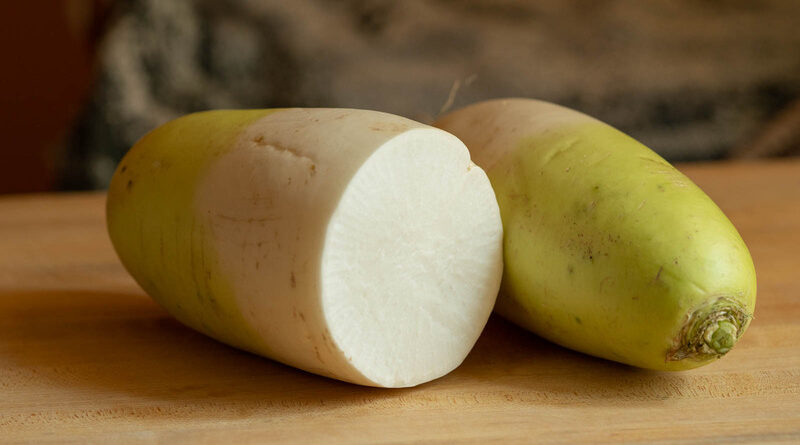Discover the Secret of Korean Daikon: Unveiling Culinary Magic
Welcome to the dynamic world of Korean food, where ingredients tell tales of invention and heritage as flavors dance on your tongue. This essay explores the world of Korean daikon, a modest but adaptable vegetable with a unique role in Korean culinary tradition.
Join us as we explore the delights of Korean daikon and how it has affected global gastronomy, including its array of culinary applications and health advantages. Be ready to be amazed by the wonder of Korean daikon whether you’re an experienced foodie or a curious beginner.
Varieties of Korean Daikon
Korean daikon, sometimes referred to as “mu” comes in a range of conventional and specialized variants. Each with its distinct flavors and textures.
Korean daikon offers a varied palate for culinary exploration, ranging from the widely grown Joseonmu to regional variations like the spicier daikon of Gyeonggi Province and specialist types like Mu Saengchae.
Seasonal and hybrid types ensure a colorful and adaptable component for both traditional and modern Korean cuisine. Thus enhancing the culinary scene.
Korean Daikon Growing and Harvesting Techniques
Like other radishes, Korean daikon is quite simple to produce and harvest. The following are some salient points:
Ideal Growing Conditions:
Korean daikon grows well in cool, temperate settings with lots of sunshine and well-drained soil.
Planting and Germination:
Direct seeding takes place in the garden bed; seeds are planted ½ inch deep and spaced 4–6 inches apart. When the seeds germinate, which typically takes five to seven days, keep the soil continuously moist.
Watering and Maintenance:
Healthy development depends on regular irrigation to maintain uniform soil moisture, mulching to retain moisture, and maintaining the area clear of weeds.
Thinning and Pruning:
To enhance air circulation and lower the danger of pests and diseases, thin seedlings provide room for healthy root development and clip leaves and stems.
Harvesting:
After planting, daikon usually takes 45 to 60 days to be ready for harvest. The roots should be crisp, and solid, and grow to the appropriate length—typically 8 to 12 inches. Before removing the roots, carefully work the dirt surrounding them free.
Storage and Preservation:
You may keep fresh daikon in the fridge for two to three weeks. For longer-term storage, it can also be preserved by fermenting, pickling, or freezing.
Nutritional Benefits of Korean Daikon and Culinary Uses
Korean daikon has many health advantages due to its high fiber, vitamin, and mineral content and low-calorie level. It enhances heart health, strengthens immunity, and improves digestive health. It can be used in a variety of culinary applications due to its mild flavor and crisp texture.
In a variety of recipes, daikon lends a crisp, refreshing taste to anything from raw salads to pickled sauces and cooked meals. Korean daikon adds flavor and nutrition to food, whether it is used in classic Korean cuisine or contemporary fusion cuisine.
Traditional Korean Daikon Recipes
Daikon is a staple in many traditional Korean recipes, and the cuisine has a rich tapestry of flavors. From the well-known kimchi to the cozy Mu Guk, daikon gives these traditional dishes a distinct crunch and rich flavor.
With these traditional Korean daikon recipes, you may experience the essence of Korean culinary tradition and satisfy your cravings for either the savory goodness of Oi Sobagi or the fiery tang of Mu Saengchae.
Modern and Fusion Cuisine Incorporating Korean Daikon
Korean Daikon Radish Tacos:
A modern take on a classic taco, loaded with grilled chicken or tofu, avocado slices, and julienned Korean daikon, all topped with sriracha mayo for a fiery finish.
Daikon Salad Rolls:
Light and refreshing salad rolls rolled in rice paper and topped with shredded lettuce, fresh herbs, shrimp or tofu, and peanut or hoisin dipping sauce.
Daikon Radish Noodle Salad:
A tasty and nourishing salad consisting of spiralized daikon noodles, mixed greens, grilled beef or chicken, cherry tomatoes, and ginger sesame dressing.
Korean Daikon Radish Sushi Rolls:
A unique take on conventional sushi is these colorful low carb sushi rolls with cooked shrimp or crab, cucumber strips, avocado slices, and julienned daikon. They are served with wasabi and soy sauce and are wrapped in nori sheets.
Health Benefits and Potential Risks
Health Benefits:
Among its many health advantages is that it is a great source of fiber, vitamin C, potassium, and folate, among other important nutrients. It strengthens the immune system, helps heart health, and supports digestive health.
Potential Risks:
It is safe for the majority of individuals, although there are concerns for others. Although uncommon, allergic responses might occur, particularly in people who are allergic to similar vegetables like mustard or cabbage. Goitrogens, which can have a significant impact on thyroid function, are also present in daikon. For those who are sensitive, overindulging may cause intestinal distress.
Tips for Safe Consumption:
Eat daikon sparingly as part of a well-balanced diet. Daikon’s goitrogenic effects can be mitigated by cooking it, and it’s crucial to be mindful of any potential sensitivities. It is essential to speak with a healthcare provider if you have negative responses.
Conclusion
To sum up, it is a testament to the diverse range of Korean cuisine that successfully combines innovation and tradition. Its many kinds provide a colorful palate for culinary discovery, ranging from the widely grown Joseonmu to specialist hybrids.
Daikon, with its crisp texture and mild flavor, enhances both traditional and modern Korean cuisine, making it a mainstay thanks to its simple growing methods and a plethora of culinary applications. Its importance in a balanced diet is further highlighted by its nutritional advantages, which include support for immunity and the maintenance of digestive health.
Incorporating Korean daikon into meals may be a delightful excursion into the heart of Korean culinary heritage, enticing both seasoned lovers and interested newcomers alike—just be cautious of potential hazards including allergies and goitrogens.
